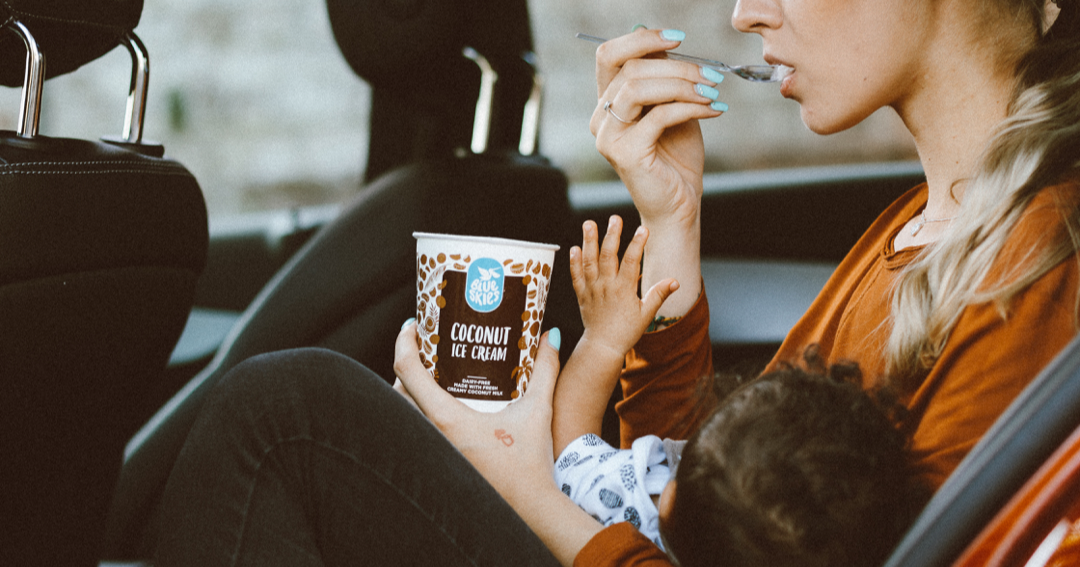Living with type 1 diabetes, in general, is kind of like taking care of a newborn baby every day. All day.
Your “baby” takes a lot of naps, so there are times you can think about him or her a little less, but that baby is still your responsibility 24 hours a day. There are no babysitters you can hire.
The baby could wake up at any point in the night, or interrupt your workday moments before you were about to give a giant presentation. Your baby is needy and demanding and non-stop.
Only, diabetes isn’t nearly as cute or rewarding as a real baby!
Now, add real human children to that list of responsibilities, and managing type 1 diabetes becomes a very different ball game.
Parenting With Diabetes
The more blood sugar fluctuations and unpredictable highs and lows that occur, the more diabetes severely impacts your ability to parent.
It is far more complicated than a simple blanket statement of “parenting is harder when you have diabetes.”
It’s a constant balancing act of attempting to keep your blood sugar in your goal range, while also trying to prevent low blood sugars so that you can properly take care of your child and simply be the parent that your non-stop-action, beautiful, wonderful, baby needs!
I have two of my own, ages 2 and 4, and they have absolutely changed the way I manage my diabetes.
I expected parenting to increase my A1c, but I was thrilled to find that my last A1c had actually gone down from that first postpartum result of 6.5% to 6.% over the course of the last year!
Here’s how I’ve been able to make it work.
1. Choose Low Carb Meals Before Activity
If you’re about to take your kids to the playground, this is definitely not the time to load up on carbs. You’re simply increasing the likelihood of a low blood sugar.
All those carbs, and all that insulin to counteract the carbs, plus all the running around means you're in for a very wild ride. And not the good kind.
Instead, if you know you’re heading to the playground, choose a very low carb meal beforehand that requires essentially zero insulin or a maximum of 15 grams.
(And naturally, eating lower carb in general will help to ensure fewer blood sugar fluctuations throughout the entire day!)
Examples look like:
✅ 1 apple with peanut butter, and carrots
✅ a salad with chicken, veggies, high-fat dressing
✅ lettuce roll-ups with deli-meat, cheese, onions and mustard
✅ psyllium bread rolls with deli-meat, cheese, onions and mustard
✅ a big bowl of microwaved/sauteed veggies and a few slices of cheese
✅ flaxseed muffin in a mug and 2 eggs over-easy
PRO-TIP 💡: If you decide to eat a fruit with your lunch (which will require more insulin), consider eating it right before leaving, and only take 50% of your usual insulin dose. Or even less depending on just how active you intend to be!

When choosing options like the ones above, you’re being very, very careful and calculated by reducing the number of carbs, which reduces the amount of insulin you need, which reduces the risk of hypoglycemia.
2. Consider Intermittent Fasting
My favorite thing about intermittent fasting as a parent is that it means I have a huge chunk of the day during which I’m not taking any boluses of insulin for food.
This means that from the moment I wake up until about 1 p.m., I can chase my kids around a playground, up the driveway, or walk in the woods with a 25 lb. baby on my back, and I do not worry about hypoglycemia.
Ideally, when fasting, you’re waking up with an in-range blood sugar and your background/basal insulin doses are already fine-tuned to ensure your blood sugar is consistently in-range without a meal or bolus for carbs.
Because when you eliminate that insulin variable, you also eliminate the hypoglycemia risk.
(Read more about intermittent fasting here)
3. Keep Very Specific Carbs On-Hand to Treat Lows
As a parent, the last thing you need is to spend an entire day on a blood sugar rollercoaster!
So if and when your blood sugar starts to go low, use extremely specific things to treat your lows that you can also store easily just about everywhere (the diaper bag, the glove-compartment in your car, your purse, all of your jackets’ pockets, etc.).
That way, you can treat it quickly and easily, and won't have to give another moment's thought to where your blood sugar is headed.
Remember, sometimes, to get off the coaster, you have to let your blood sugar run a little high until the ride is done if it means preventing another low while caring for children.
Here are a few specific carbs to use to treat lows:
✅ small apple juice bottles (not boxes, which mold, or crack open)
✅ Welch’s fruit snacks from Costco (1 package can easily treat severe lows)
✅ Halloween-sized packs of Skittles (4 grams per Skittle)
✅ Wonka Pixy Stix (15 grams per 7 stix)
✅ mini SunMaid boxes of raisins (22 grams per box)
Check out more ideas here!
4. Keep a Box of Cereal in Your Home at All Times
While cereal is usually something I’d consider the devil as a person with diabetes, it’s also saved my life many times.
There’s almost no easier way to quickly consume 50+ grams of fast-acting carbohydrate when you realize that your blood sugar is plummeting fast and you’ve got a lot of insulin onboard.
There are hundreds of scenarios I could use to describe why you'd need a cereal back-up, but here’s just one: you just ate lunch and took all the insulin for that lunch. Suddenly, one baby pukes all over the living room, while you were trying to get the other kid ready for school, and then your dog shows up at the door covered in something nasty she rolled-in, and you’re running around like a crazy person trying to manage everyone and your blood sugar is plummeting because you took way too much insulin for this much activity because you had no idea (of course not!) that this kind of action was about to go down.
This is exactly the time that a very large bowl of cereal comes in handy. It can prevent an otherwise very scary situation.
5. Loosen Up On Your Blood Sugar Goals
This is especially true if your kids are young. There are absolutely times when choosing to spend the afternoon with a blood sugar of 160 mg/dL might be a much, much safer game-plan than trying to get it back down to a solid (and better) 90 mg/dL.
For example: if you’re headed to a kid-focused holiday event, you have no idea what's about to go down.
Maybe this event will require you to run around chasing both kids, or maybe they’re going to be sitting at a table while quietly decorating cookies.
If my blood sugar is 160 mg/dL before an uncertain activity like that (one that I absolutely cannot control), I’m going to maybe take a tiny smidge of insulin or none at all.
Then, once I get to the event and can feel out the situation, I might rethink a correction dose.

Kids are are an entirely different variable in the everyday life of living with type 1 diabetes. As a mother of two and a person living with T1D, I can certainly attest to this.
But T1D management is pretty crazy, too! So doing what you personally need to do to ensure the safety of both you and your children truly comes before having the perfect A1c.
You've got this!





